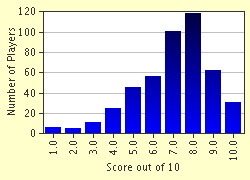Quiz Answer Key and Fun Facts
1. Which of these best describes the geographical location of Singapore?
2. The Japanese had planned the invasion of Malaya for over a year. Why was Malaya an important objective to them?
3. British Command had concluded that Singapore would be attacked, and could only be attacked from the sea and air.
4. The British officers had preconceived opinions of what the Japanese soldier was like. Which best describes this opinion?
5. The Japanese landed in Malaya and Thailand on the 8th December 1941. How long was it before they met the final defences at Singapore, a distance of over 550 miles from their landing sites?
6. The troops that were cut off during the allies' full retreat were captured and sent to their units in Singapore after the island fell.
7. A British battleship and a battlecruiser were dispatched to the eastern coast of Malaya to engage the invasion force. They were to be the first British capital ships sunk by aircraft on the high seas, and only a few days after Pearl Harbour. What were their names?
8. With the air defence wiped out, the navy out of action and the causeway blown up, allied troops had to make a final stand on the island of Singapore. General Percival was blamed for what poor strategy in the defence of the island?
9. If the British had of continued the fight in Singapore in 'street fighting', they would have beaten the Japanese forces as they were out of ammunition, food and fuel.
10. 100,000 troops were now "guests of the Empire of Japan" and placed in a now infamous POW camp. What was the name of this camp?
Source: Author
bertho
This quiz was reviewed by FunTrivia editor
bloomsby before going online.
Any errors found in FunTrivia content are routinely corrected through our feedback system.

